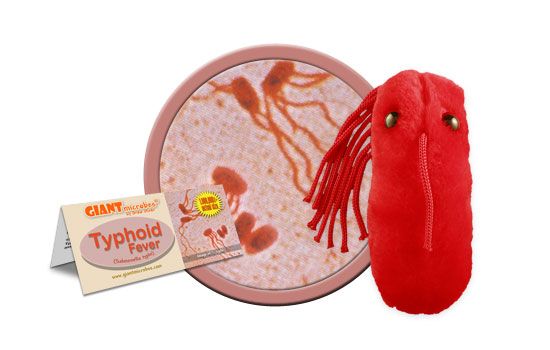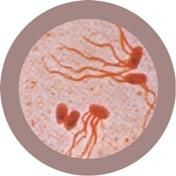Typhoid Fever (Salmonella typhi)
Product Details
Additional Information
| Sizes | Giantmicrobes are based on actual microbes, cells, organisms and other critters, only 1,000,000 times actual size! Gigantic (GG) 16-24" XL (XL) 10-15" Original (PD) 5-8" Keychain (KC) 2-4" with clip |
|---|---|
| Materials | Plush from all new materials. Stuffed with polyester fiber fill. Surface washable: sponge with water & soap, air dry. |
| Packaging | Each plush microbe includes a printed card with fun, educational and fascinating facts about the actual microbe or cell. |
| Safety | Every product meets or exceeds U.S. and European standards for safety. For ages 3 and up. |
All about Typhoid Fever (Salmonella typhi)
FACTS: After a week or two incubation period with Salmonella typhi, Typhoid Fever strikes causing hemorrhagic red spots on the chest and abdomen, ulceration of the intestines, and an extremely high fever that can last well over a month. Untreated, the mortality rate is as high as 20%.
Fortunately, there are now vaccines that are up to 70% effective. In addition, although typhoid fever can exhibit some antibiotic resistance, it is generally responsive to treatment.
Although typhoid fever is now rare, at the turn of the 20th century it was far more common. Common enough, in fact, that one Mary Mallon, a cook in New York, became a carrier. As she moved from house to house, one by one her employers fell ill. She denied ever having had the disease (and indeed, mild cases can be confused with the flu), but New York officials had her tested, discovered that she was a carrier, and ordered her quarantined. She was eventually released, but promptly adopted a false name and returned to her trade. She was subsequently apprehended a second time, but not before leaving a trail of cases – and several deaths.
Though other healthy carriers also caused inadvertent cases, Typhoid Mary's refusal to cooperate with officials indelibly associated her name with the disease.
| Name | The name typhoid means "resembling typhus" due to the similarity in symptoms. These two diseases are caused by different genera of bacteria. |
|---|
| Where It Lives | Typhoid fever is caused by Salmonella typhi bacteria and is spread through contaminated food and water, as well as through close contact with an infected person |
|---|
| Symptoms | Fever, headache, rash, weakness and muscle aches, abdominal pain and diarrhea or constipation. The later stage of the illness causes delirium and typhoid state (lying motionless with eyes half-closed) |
|---|
| Cure | Oral antibiotics and drinking fluids |
|---|
| History |
1880: Discovered by William Budd in England Big Outbreaks: 1903: A water source in Ithaca, NY, was polluted from a dam construction site that resulted in an outbreak involving 1,350 people 1924: Oysters from Long Island, NY, held in polluted waters affected more than 1,500 in New York, Chicago, and Washington, D.C. 2004: 13,000 cases due to contaminated drinking water in the Democratic Republic of the Congo Recent Outbreaks: 2015: A total of 1940 suspected cases in Uganda due to contaminated drinking water and juices |
|---|
| Fascinating Facts |
Doctors used to prescribe chloramphenicol, but it caused widespread bacterial resistance Approximately 3%-5% of patients become carriers of the bacteria In 2006 there were only 314 reported causes of typhoid fever in the U.S. |
|---|






